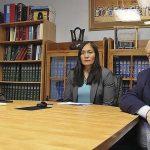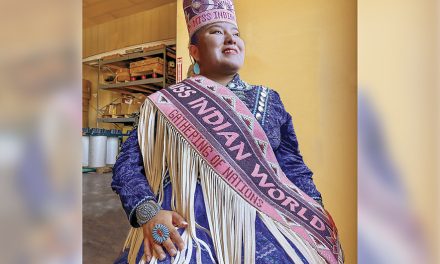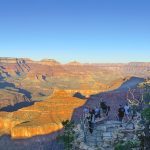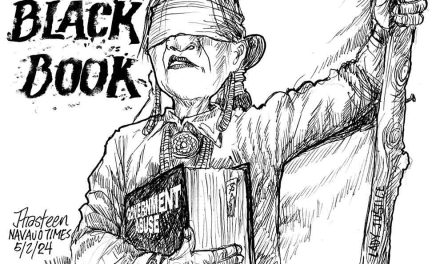
Letters: We are the wave; it is us!
We are about 10 months into the COVID-19 pandemic. What have we realized about ourselves, as well as our relationship to this parasitic virus? First, some called it “an invisible monster,” a beast we cannot see when in actuality it is a microscopic parasitic organism.
Even though it does not possess a brain, it behaves and moves about with its natural instincts and in connecting relationships with its encounters. Do not take this virus for granted; it is very intelligent, impulse-driven, and an opportunist. The virus uses the human host as its transport and delivery system.
That is how people get infected: by another human. Prevention is simple by complying with established standardized health precautions and mandates. As Indigenous, how proud we are, the originals of this continent, to say we possess perseverance, which we display as “resilience.”
Yes, this is true, our determination not to be shoved around, which invokes our stubbornness. Now, we refuse to comply with our own laws, policies, tradition, cultural knowledge, or whatever implemented boundary containment fences are before us.
As this moment, for some, it is down to not wearing facemasks, social distancing, hand washing, stay-at-home mandates, and other insistences by social authority.
It is this choice of stubbornness, to not listen and not act upon life-saving practices that become our downfall, and our people die. It is yet to be known if this is our death wish or something else. And our social authority speaks of forthcoming numbered viral waves.
Common sense dictates, whatever number alleged wave it is — we are the wave. It is us! We are the carriers and spreaders of COVID-19. It becomes our wave as we madly rush to secure our non-essentials and gifts for Christmas, holiday get-togethers, homecoming celebrations, and simple home visits, because of loneliness, etc. And social authority and the health profession establishments are overwhelmed with grave consequences from the after-effects from such gatherings and activities.
These are self-evident in our never-ending climbing statistics of new cases and increasing death toll. They might as well establish precognition enforcement standards or ideas, where initial carriers and spreaders be considered premeditated murderers to those they infect who then die. We have met our challenge and this is not even a David and Goliath equivalent.
Sadly, if it were, then in this scene we would not be David. We would be the other guy with the club and fancy weapons, and we know how that ends. By ignorantly helping the virus, it is our own undoing which may determine who will exist on this planet. Our challenge is to face ourselves in the mirror for redemption.
Forget arrogance and ignorance, they serve no real purpose. Therefore, until help arrives, have some dignity and heart. Our choice is obviously simple — mask up, stay home, and comply with all suggested precautions from our overworked, stressed-out health-related authorities, with their rapidly depleting resources. With compassion and mindfulness, grant them some breathing space.
Robert L. Hosteen
Beclabito, N.M.
Winter solstice is a special time
Dec. 21 marks the day when the sun appears “stationary” for at least three days, a time where we see the shortest day and the longest night as the winter solstice in the northern hemisphere.
Many people do not realize this special time is taking place with sacred observances celebrated around the world. In the southern hemisphere, the winter solstice occurs in June, which marks the summer solstice in our northern hemispheric calendar. According to some international scholars, “solstice” is a compound word from Latin meaning “sun stands still.”
The cosmic solstice cycle is an incredibly meaningful observance for cultures around the world as a time for renewal, evoke peace, prosperity, goodwill, a new beginning, a renewal to and for Mother Earth’s sustenance.
For some of us, we remember as youngsters we were told this time is considered very sacred and special for this time marks “the rebirth of the sun,” or “Johonaa’ei Naachii’. This time has also been called, “Shan’ Niigha’, “the end of sun’s summer journey,” at least in some sectors of our homeland. During the winter solstice, with the long winter nights, many recall evenings after dinner in the hogan — dinner on a cloth on the dirt floor in the sacred home, the hogan — were spent on cultural stories of the coyote tales, ma’ii joolglosh, winter night sky constellation stories, string games, keh ninaaljeh, shoe game, and many other winter stories from grandparents who, with their tone of voice, gestures and vocabulary, gave real life to the stories’ do’s and don’ts for the grandchildren’s well-being, for their life journey.
The primacy of orality, oral cultures, offered life lessons rich in expression, power, strength, grace, beauty, and fluidity, making possible a much broader and deeper spectrum of understanding and appreciation.
The primacy of enriched oral stories is largely remiss today in emerging chirographic (literary) cultures where many in America’s educational system are still too eager to dismiss Native true knowing as primitive thin brittle knowledge.
While there are conflicts about writing, it is at the risk of literature inviting further fragmentation of orality, fragmentation of the strength, harmony and richness inherent in Dine’ orality, that we now have to acquire traditional knowledge and our winter stories in digital literary form. With our southern pre-Inca scholar contacts, at least in Tiwanaku, Bolivia, this “return of the sun” winter solstice ceremony is the beginning of a new dawn, the greeting of the sun’s rays, the rising sun, a new year, with sacred observances and ceremonies for hope, a long life, tranquility, harmony, and a fruitful new beginning for all living things, a renewal for Mother Earth’s sustenance.
These deeply sanctimonious values, among other core fundamental values, appear universal whether it is within the sacred cultural observances of the Native peoples of the Americas, the Greco-Roman winter solstice, the Mongolian “compassionate heart of purification” with a spiritual journey to the North Star, the Pakistani Kalash People “Chaomos,” the Germanic-Scandinavian Yuletide, the list goes on.
The sacred observances and spiritual communion may well reflect profound values of compassionate acts of kindness, collective efforts for inspiration, a long life, a healthy mind, body and spirit, a fruitful new beginning for all living things, and a renewal for Mother Earth’s sustenance. The spiritual offerings would appear to show the breadth and depth of what defines humanity at its core, giving light to the complexity of mankind as “No’hooka’ Diné,’” earth-surface peoples, as thoughtful human beings. In these unprecedented challenging times, there is not a greater time for acts of generosity and spirit of service to others.
In Diné traditional teachings, hardship is there for a purpose. Hardship is a wake-up call, a time to pull off the congested highway in one’s life and pull into a rest stop. Hardship is a time for deep critical reflection with oneself, a time for soul-searching, a time to tap into abilities, talents, strength that we never knew we had, a time to bring out the best in us to face adversities, challenges, and resolve hardships.
The sacred observances and spiritual ceremonies may well be the very special time to bring out within us the profound values of compassionate acts of kindness, inspiration, a fruitful new beginning for all living things, determination, courage, resiliency, self-efficacy, collective efficacy, and a renewal for Mother Earth’s sustenance.
In our winter stories and ceremonies, we were told making positive differences for others begins with making and cultivating that positive difference within ourselves, within one’s selfhood, and only then are we able to engage in acts of generosity and spirit of service to others. In these unprecedented times, it becomes particularly crucial to maybe revisit, honor, empower, and give life to the teachings from our traditions that await us.
Harold G. Begay
To’Nanees’Dizi, Ariz.
Controller’s news release was unfair to chapters
This letter is to response to a “news release” made public by the Navajo Nation Office of the Controller dated Nov. 24 regarding the $90 million CARES Act funds that were allocated to the 110 chapters which was identified as the chapter distribution program to help their community people with their needs to mitigate the COVID-19 pandemic.
All 110 chapters were given directive from their upper management department, the Division of Community Development. In order for chapters to receive their allocated CARES Act funds, they must conduct community assessments. So all 110 chapters have conducted various ways to collect data for their assessment to determine the needs of each community.
All those data collection were than compiled and narrowed down to the following categories to comply with federal guidelines.
• Personal protective equipment
• Essential sanitation items
• Essential fuel source
• Essential food item
• Essential services
• Infrastructure upgrades
• Infrastructure equipment
• Emergency essential support
• Emergency hardship Assistance
• Payment of chapters and senior centers
The Navajo Nation Council gave full authority to the controller’s office to handle the CARES Act funds and the office hired outside consultants (Baker Tilly) to help with the funds. A portal was set up but as soon as it launched, it crashed. It crashed so many times that the chapters ended up uploading their documents in Excel format, which was a total disaster when chapters were racing against time.
The 110 chapter government staff of two did their darnedest to meet the timeline. This was very stressful for them to collect data/assessments to identify their communities’ needs to mitigate COVID-19 pandemic while alongside losing their loves ones by the numbers. Each community is different and has different needs.
Based on that, the chapters were able to develop a budget to comply with the federal guidelines but yet our own Navajo employee (controller) has criticized the chapters in her news release.
The controller’s office needs to apologize to the 110 chapter governments. This is not acceptable. The chapters requested to purchase Pendleton blankets for their people. Our Native people have used Pendleton blankets since their inception, why do we want to purchase cheap stuff like fire blankets?
Internet services: Mexican Water Chapter has no landline telephone, so the only communications available is cell phone service but even the service is not consistent.
Our students are struggling with their educational needs, San Juan School District/state of Utah public education pulled the distance learning and made the students do in-person classes, put our students at-risk, on top of that parents end up driving their children to school every day which was a burden on their finances.
Over 80 homes have no running water. The windmills had gone dry. The most important thing to mitigate COVID-19 was to wash hands but this cannot happen if there is no running water/sanitation. Our people are told from our leadership about the lockdowns but there is no food supply coming through for the people. The cold weather has set in and many of our elderly, young families that are already experiencing hardship do not have firewood to keep warm.
Still limited PPE, some families are re-using dirty disposable masks and in the midst of the second wave of the virus. We have two chapter staff working the front lines, coordinating essential services, but their request for essential pay and workers has been denied. Navajo Nation central government and the NNC have only approved one quarter of its annual budget for operation which ends in December and yet personnel are still working the front lines being denied special duty pay.
David John
Vice President
Mexican Water Chapter
My mother turned away by Tséhootsoí Medical Center
Recently, my whole family experienced the effects of COVID-19 and, thankfully, we recovered and have one recovering still. I commend the efforts of all the medical professionals as they continue their fight in this war against the virus.
However, my mother was seen at Tséhootsooí Medical Center four times on four consecutive days and each time was turned away and not tested. She was obviously in distress and was told each time her symptoms did not correspond to any signs of the virus. She suffered a week and was seen those numerous times and presented with labored breathing and all the effects that should have signaled being positive for COVID-19.
Ultimately, she called Gallup Indian Medical Center and was admitted after speaking with a nurse who advised she present herself to the emergency room immediately. When she arrived at GIMC she was tested and admitted. She was seen four times at TMC and was never tested. The rationale behind not testing was explained away as a cold.
I cannot comprehend why TMC would do that. Is there a shortage of testing supplies, or worse, incompetence on the part of the staff at TMC?
In either case, TMC seems to enjoy a better reputation than GIMC. That reputation is obviously mistaken, and I caution anyone who holds that estimation. After three weeks in the hospital, including a week spent in the ICU ward, my mother returned to us. She is using oxygen and is improving only by the grace of God through prayer. TMC, as a medical facility, could have caused a needless and careless loss, and I believe is not acting in the best interest of us as a people.
I worry others were turned away as well and who knows their outcomes. The deaths our Navajo Nation experiences because of COVID-19 are tragic. We trust and expect that medical professionals on the reservation are here to help and improve a broken health care system.
Tséhootsooí Medical Center is a PL 93-638 entity and their funding, whatever amount, should be scrutinized by our Council. Why are people turned away when I understand the hospital is fully staffed while limiting appointments and determining whom to see by telephone consults?
My indignation for that organization is only tempered by the thought that they have helped some. Any CARES Act funding TMC received should be reverted to those medical facilities that help — including, specifically, GIMC.
What a waste of funds to pay for a corporation that is fully staffed and will not see suffering people. If there is a class action lawsuit against TMC, people within their service area should document their experience and participate.
The leadership at TMC boasts that they provide guidance and are responsible for a much-needed service to the nation. There is a void that I see and recommend a recall of all board members with new appointees who have experience and credentials to match.
GIMC has improved some and as their motto goes, “Teamwork makes the dream work.” Teamwork and a dream. I think GIMC may be turning a corner toward improving their reputation for their response to this pandemic. And it seems TMC is complacent in their charge for treating and caring for our people.
The CARES Act funding and its use by TMC needs a close examination by our Council with the corporation’s expenditures published by our local newspapers. Any lack of accountability only continues the cycle of paid incompetence and mistrust in the corporation’s judgment.
“Hope” is not a plan of action in changing TMC for the better. Scrutinizing, hard questions and accountability for Tséhootsooí Medical Center by the Navajo Nation is necessary.
During this time of fear and dread, we as a nation, need to turn to the grace and mercy of the Lord. There is a power He has beyond our feeble understanding and is revealed to us by our prayers. If we turn to Him who wants to hear from us, and lay our troubles before Him, He will hear our cries and do a powerful work.
Only through my own difficulties and pain have I continued to prove His willingness to keep me. May our Lord who is gracious and kind continue to watch over you and your families.
This is a difficult and heartbreaking time for those who have lost a loved one during the holiday season due to COVID-19. Our heartbreak is only exacerbated by the “what ifs.” Turn to Him for comfort and know that He hears us and has provided the only way to redemption through His son, Jesus Christ.
Rhianan Curley
Coyote Canyon/Brimhall, N.M.
Positive ideas in pandemic fight
I just wanted to give some positive ideas to fight COVID and keep our tribe in good health care. We close all casinos and turn them into hospitals and clinics, retrain casino staff. Why casinos?
They really don’t do anything positive for our people, but make you broke … no tribal discount in the diner and no tribal dividends from casino profit. Close them.
Twin Arrows could be a nice hospital trauma center with a helicopter landing and it has a paved parking lot.
Fire Rock could be a nice satellite clinic for stable patients and a good location leaves main hospital for more serious patients. Northern Edge could also be a nice satellite clinic and it has paved parking.
The kitchen can be converted into a cafeteria. Closing all casinos and turning them into high-tech clinics and trauma centers would be very good for our people. COVID relief funds for the Navajo Nation seem to be a myth and hearsay.
I didn’t know they hired a non-Diné bilagaana firm to keep track of the beeso. As a musician, I filled out an application for artisan COVID relief for our band, but I was told it was taken away after I gave them all my private information and CIB.
Now this firm has my info to sell, share, and hack. The COVID relief funds seem to change from day to day.
All I can say is I’m like a lot of other folks. I’m behind on rent and utilities and my SUV needs a motor and my motorcycle is also down. Hours were cut to zero due to the lockdown.
To be honest, I really think our leaders are out of touch with the people’s needs. People are dying, getting evicted, and NTUA shutting off utilities during this pandemic, repo’s, the list goes on. I’m worried and just want to go back to work, playing music, and my regular day job.
Richard Anderson Jr.
Gallup, N.M.








 Highway 264,
Highway 264, I-40, WB @ Winslow
I-40, WB @ Winslow